
Hidden knowledge is often inscribed in coded letters. This page highlights some of the more popular methods of encoding occult secrets. Sigils are a related but distinct concept in occult studies where either a practitioner uses a secret or created sign to invoke a spirit or manifest a desired effect. A few texts with untranslated ciphers or languages are listed in the Manuscript page.
Most of the “occult alphabets” are simple substitution . Instead of creating an entire language, one may simply create a new alphabet that correlates to the letters of the language you wish to encode (for example, A is represented by a circle, B by a square, etc.). However, substitute ciphers are easy to spot and decode with minimal knowledge and skill. Given that the encoded text is long enough, repeated letters or common words stand out. From there, a decoder can work out the rest of the letters rather easily with guess and check. Short substitute ciphers, a few characters at most, are almost impossible to decode but also limited in their usefulness.
![]() As such, these occult alphabets are more useful for their aesthetic value or ritualistic purposes. However, employing more complicated ciphers in addition to these unique alphabets could easily hide content from all but master codebreakers.
As such, these occult alphabets are more useful for their aesthetic value or ritualistic purposes. However, employing more complicated ciphers in addition to these unique alphabets could easily hide content from all but master codebreakers.
![]() The use of encoding and decoding text is generally called “cryptography”. Modern cryptography is mostly concerned with computer and network security and as such is only possible with high-tech software. The adoption of machine assisted encryption was cemented with the “Enigma Machine” in World War II. Prior to the 20th century, techniques for encoding text to keep it secret had been evolving since ancient times but had to be done via “pen and paper” and comparatively rudimentary encryption tools.
The use of encoding and decoding text is generally called “cryptography”. Modern cryptography is mostly concerned with computer and network security and as such is only possible with high-tech software. The adoption of machine assisted encryption was cemented with the “Enigma Machine” in World War II. Prior to the 20th century, techniques for encoding text to keep it secret had been evolving since ancient times but had to be done via “pen and paper” and comparatively rudimentary encryption tools.

As the entire purpose of cryptography is to conceal, it naturally occurs within occult and esoteric traditions. Its use, however, is distinctive from its other major applications throughout history, the aforementioned militaristic and espionage. In the later, sensitive information such as plans, coordinates, and communications are concealed from hostile forces. It is tangible, concrete information. In its occult form, breaking a cipher or solving a code may be the easiest part of deciphering the intended message. More commonly occult texts will utilize metaphor, allegory, or an oral recitation from master to student to secure its teachings. The first two require additional knowledge, typically gained by joining the group who produced it (for example, the Rosicrucian movement) or tutelage from a wise individual who likewise received it from other masters. This ties into the use of oral tradition as well.
Kabbalah is generally understood by its practitioners as having been transmitted exclusively by speech for hundreds of years explicitly to avoid the pitfalls of textual misinterpretation. It’s much less likely for a student to misunderstand a subject when they have an active teacher available to correct their mistakes and answer questions. In contrast, books can’t clarify or correct their readers. Ask ten people what the same bible verse means and you’re likely to get ten different answers (and I’ve heard when it comes to Judaic exegesis two rabbis will have three opinions between them). This isn’t to say books are bad at transmitting knowledge; they obviously have advantages. My point is to highlight how and why different traditions used different methods of concealment.
Having clarified the basics, below are several notable ciphers and encryption methods one might encounter in an occult context:
Pigpen Cipher – Also known as a “Masonic Cipher”, referring to the secretive Freemasons, this is a simple substitution cipher that uses dots and boxes in a pattern to denote letters of the alphabet. It has also been connected with the Rosicrucians. Here is a typical example:

![]()
An example in Manhattan’s Trinity Church Graveyard, via Atlas Obscura, is an 18th century grave with Masonic carvings and a grim memento mori.
Caesar Cipher – One of the most well known ciphers, this is a simple “shift cipher”. All you have to do to encode a message is shift, or move, a set number of letters on the alphabet to the new corresponding letter. For example, a shift of three letters to the right takes the alphabet:
ABCDEFGHIJKLMNOPQRSTUVWXYZ
To align with:
DEFGHIJKLMNOPQRSTUVWXYZABC
So now A=D, B=E, etc. You’ve probably seen this cipher used for “decoder rings”.
Theban Alphabet – Appearing in Johannes Trithemius’ Polygraphia (published in 1518), this alphabet is attributed to the Sworn Book of Honorius (a supposed magician from Thebes, hence the name). However, no surviving manuscripts from before Trithemius’ feature the alphabet. It is often referred to as the “Witches’ Alphabet” due to its popular use in Witchcraft and Wicca.

Celestial Alphabet, Transitus Fluvii (The Passing of the River), and Malachim – A student of Trithemius, Cornelius Agrippa featured several occult alphabets in his Three Books of Occult Philosophy.
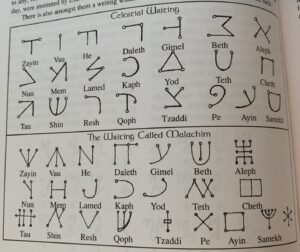
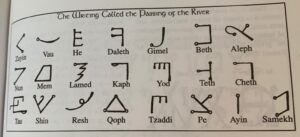
Enochian – This language and its alphabet were produced by John Dee and his scryer Edward Kelley between 1581 and 1585. Though it and its associated type of ritual magic (practiced by its progenitor Dee) are known as “Enochian”, Dee only ever described it in his writings as “Angelic” or as the language of Adam and Enoch and never named it. The two most relevant sources for Dee’s work are part of the British Library’s Sloane collection, though they have not been digitized:

There are a few other topics that are related to occult language:
Tetragrammaton – Referring to the four Hebrew letters that make up the sacred name of G*d, it is not uncommon to find this phrase or the Hebrew letters themselves used throughout western occultism.
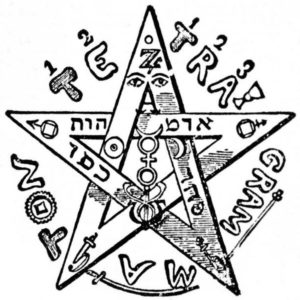

Gematria – The scholar Gershom Scholem attests that the first recorded instance of “gematria” dates to approximately 707 BC. The practice involves assigning number values to letters and deriving meaning from the sums of names and phrases. Hebrew was especially well suited as it already assigned numbers to each letter of its alphabet. Scholem cites the first use in rabbinic literature as taking place in the second century. Since then, gematria has only grown in popularity in esoteric and occult circles, especially in Kabbalah. It is also common in conspiracy theories that seek to suss out “hidden messages” in innocuous phrases. Keep in mind that this interpretive method is only valid as long as the source text has not been translated and has been reproduced exactly to the letter. If even one letter is different, the resulting calculation will be different. It is an exacting and highly interpretive process and is perhaps better suited to contemplation than producing measurable results.
Sator Square and Number Squares – While both of these have numerous levels of interpretation, the most common explanation for their use in magic and occultism is that the special arrangement of letters or numbers fascinates and distracts evil spirits. In this way they serve as protective charms, often inscribed in doorways or on buildings.
The oldest instance of a Sator (or Rotas) Square is a piece of graffiti preserved in Pompeii. Written in latin, it is most often arranged:
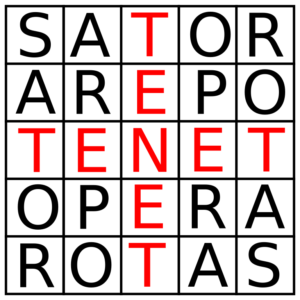
The phrase can be read in multiple directions and is (theoretically) a grammatically sound sentence. The word “Arepo” appears nowhere else in latin and if taken to be a name, the sentence roughly translates: “The sower Arepo works the wheels” (i.e. a farmer uses a plough for his work). It may be an iteration of the phrase “you reap what you show” in meaning, with the awkward wording the result of forcing the palindrome effect. This is far from the only interpretation, however, and some scholars link the word “Sator” with the Roman god Saturn or Saturnus from the Mithraic mystery cults. Despite the square predating Christianity, is has also seen extensive use by Christians, especially with the letters rearranged to form significant phrases. The most popular is the “Pater Noster” cross:
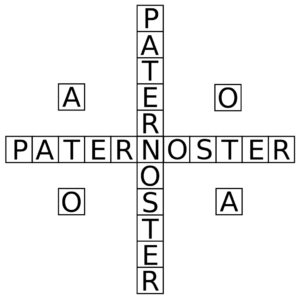
Number squares, while technically unrelated, function in a similar fashion to their lettered cousins. Numerology is explicit in the work of number squares but also occasionally applied to lettered squares via gematria.

Iamblichus on “barbarous” names – Iamblichus was a Neoplatonic philosopher from Syria who lived around the 2nd and 3rd century AD. In book VII of his work commonly known as “On the Mysteries of the Egyptians”, he argues for the use of “barbarous names”. Essentially, he said that it was justified that theurgic practices used names so old that their origins and meaning are lost. In fact, it was essential to pronounce the names exactly as tradition supplied as they had been passed down directly from the gods themselves. The name of a god, so foreign to mortal ears as to be unintelligible, possesses power in its mere utterance. The sounds, and not the understanding of the work or its meaning, is what called the god’s attention to the priest. The passage, as translated by Dillon and Gerson (citation in bibliography below) reads:
The questions that follow next require a more thorough treatment, if we are to handle them with sufficient logic; yet we should, all the same, set out the truths in our answer with brevity, for you inquire, “What is the point of meaningless names?” But they are not meaningless in the way that you think. Rather, let us grant that they are unknowable to us-or even, in some cases, known, since we may receive their explanations from the gods-but to the gods they are all significant, neither according to an effable mode nor in a way that is significant and indicative to the imaginations of human beings, but united with the gods either intellectually, or rather ineffably, and in a manner superior and more simple than according to intellect. It is essential, therefore, to remove all considerations of logic from the names of the gods, and to set aside the natural affinities of the spoken word to the physical things that exist in nature. Thus, the symbol is character of divine similitude is intellectual and divine, this being implied in the names.
And, indeed, if it is unknowable to us, this very fact is its most sacred aspect, for it is too excellent to be reduced to something knowable. But as for those names of which we have acquired a scientific analysis, through these we have knowledge of divine being and power and order-all in a name! And, moreover, we preserve in their entirety the mystical and arcane images of the gods in our soul. And we raise our soul up through these towards the gods and, as far as is possible, when it has been elevated, we experience union with the gods.
But why, from among meaningful expressions, do we prefer barbarian ones to our own? For this, again, there is a mystical reason. It is that the gods have shown that the entire dialect of the sacred peoples, such as the Assyrians and the Egyptians, is fitting for religious ceremonies, and so we think that our communication with the gods should be in the proper tongue. Also, such a mode of speech is the first and the most ancient. But most importantly, those who learned the very first names of the gods merged them with their own familiar tongue, and they delivered them to us as being proper and adapted to these things, and forever we preserve here the unshakeable law of tradition, for, whatever else pertains to the gods, it is clear that the eternal and the immutable is connatural with them.
![]()
Bibliography
Agrippa von Nettesheim, Heinrich Cornelius. Three Books of Occult Philosophy. Translated by James Freake, Llewellyn, 1993.
Dillon, John Myles, and Lloyd P. Gerson, translators. Neoplatonic Philosophy: Introductory Readings. Hackett Publishing Company, 2007.
Merkel, Ingrid, and Allen G. Debus, editors. Hermeticism and the Renaissance. Associated University Presses, 1988.
Moeller, Walter O. The Mithraic Origin and Meanings of the Rotas-Sator Square. E. J. Brill, 1973.
Partridge, Christopher, editor. The Occult World. Routledge, 2016.
Scholem, Gershom. Kabbalah. Penguin Books, 1978.
Shumaker, Wayne. Renaissance Curiosa. Medieval & Renaissance Texts & Studies, 1982.


